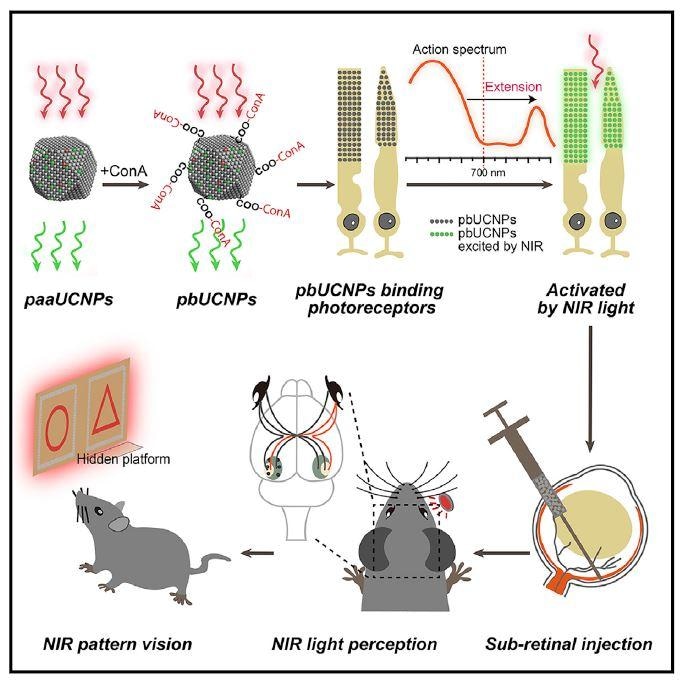Mar 1 2019
According to a new study reported in the journal Cell on February 28th, 2019, mice can see both infrared and visible light when their vision is improved by nanotechnology.
 This graphical abstract shows how injectable photoreceptor-binding particles with the ability to convert photons from to high-energy forms allow mice to develop infrared vision without compromising their normal vision and associated behavioral responses. (CREDIT: Ma et al./Current Biology)
This graphical abstract shows how injectable photoreceptor-binding particles with the ability to convert photons from to high-energy forms allow mice to develop infrared vision without compromising their normal vision and associated behavioral responses. (CREDIT: Ma et al./Current Biology)
When the mice’s eyes were injected with nanoparticles, they inherited the ability to see infrared light for around 10 weeks with reduced side effects, enabling them to view this light even in daylight conditions and with sufficient specificity to differentiate between diverse shapes. This breakthrough discovery may pave the way for considerable developments in human infrared vision technologies, including promising applications in military operations, security, and civilian encryption.
Mammals, including human, are only capable of seeing a range of wavelengths of light known as visible light, which contains the rainbow wavelengths. However, infrared radiations can be found all around the environment. Such radiations have a longer wavelength. Infrared light is emitted by animals, people, and objects because all these tend to give off heat, and infrared light can also be reflected by objects.
The visible light that can be perceived by human's natural vision occupies just a very small fraction of the electromagnetic spectrum. Electromagnetic waves longer or shorter than visible light carry lots of information.
Tian Xue, Study Senior Author, University of Science and Technology of China.
A multidisciplinary team of researchers has devised the nanotechnology to work with the existing structures of the eye. The team was headed by Xue and Jin Bao at the University of Science and Technology of China and also by Gang Han at the University of Massachusetts Medical School.
“When light enters the eye and hits the retina, the rods and cones—or photoreceptor cells—absorb the photons with visible light wavelengths and send corresponding electric signals to the brain,” stated Han. “Because infrared wavelengths are too long to be absorbed by photoreceptors, we are not able to perceive them.”
In this analysis, the researchers created nanoparticles that not only fix tightly to photoreceptor cells but also serve as very small infrared light transducers. As soon as the retina is hit by infrared light, the longer infrared wavelengths are captured by the nanoparticles and these particles release shorter wavelengths within the range of visible light. The shorter wavelength, in turn, is absorbed by the nearby cone or rod and subsequently sent as a normal signal to the brain, as if the retina was hit by visible light.
“In our experiment, nanoparticles absorbed infrared light around 980 nm in wavelength and converted it into light peaked at 535 nm, which made the infrared light appear as the color green,” stated Bao.
For their experiment, the team tested the nanoparticles in mice, which, just like humans, are incapable of seeing infrared light naturally. Mice that were injected with nanoparticles displayed unconscious physical signs, for instance, their pupils were constricted, indicating that were able to detect infrared light, whereas mice that received only the buffer solution did not react to infrared light.
To further test whether these animals are able to sense the infrared light, the team set up an array of maze tasks to demonstrate that the mice can detect infrared light even during the day, concurrently with visible light.
In exceptional cases, the injections caused side effects like cloudy corneas, but these disappeared within a week’s time. It is believed that the injection process might have caused the side effects because mice that were injected only with the buffer solution also exhibited an analogous rate of these side effects. In addition, other tests did not reveal any damage to the structure of the retina after the sub-retinal injections.
In our study, we have shown that both rods and cones bind these nanoparticles and were activated by the near-infrared light. So we believe this technology will also work in human eyes, not only for generating super vision but also for therapeutic solutions in human red color vision deficits.
Tian Xue, Study Senior Author, University of Science and Technology of China.
Present infrared technology depends on cameras and detectors that are usually restricted by ambient daylight and require external power sources. According to the researchers, the bio-integrated nanoparticles show promise for the potential use of infrared light in security, civilian encryption, and military operations.
“In the future, we think there may be room to improve the technology with a new version of organic-based nanoparticles, made of FDA-approved compounds, that appear to result in even brighter infrared vision,” stated Han.
The team also believes that more research can be done to improve the nanoparticles’ emission spectrum to suit human eyes, which are known to use more cones than rods for their central vision as opposed to mouse eyes.
“This is an exciting subject because the technology we made possible here could eventually enable human beings to see beyond our natural capabilities,” Xue said.
The study was supported by the Strategic Priority Research Program of the Chinese Academy of Science, the National Key Research and Development Program of China, the National Natural Science Foundation of China, the National Institutes of Health, a UMass OTCV award and a Worcester Foundation Mel Cutler Award, and the Human Frontier Science Program.